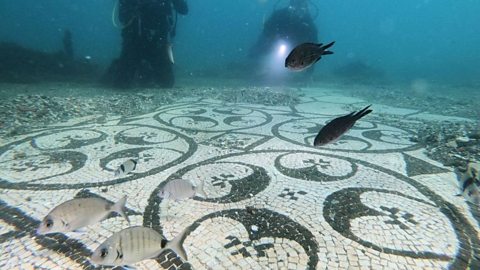Stunning in their scale, colour and detail, frescoes can give us a fascinating glimpse of ancient civilisations.
Every now and then, a new fresco is discovered which sheds further light onto how ancient people lived, worshipped and enjoyed themselves.
Join “óĻó“«Ć½ Bitesize as we discover some of the most incredible frescoes from ancient civilisations.
What is a fresco?
A fresco is a painting technique in which the colours are quickly applied to a fresh wet layer of plaster, typically on a ceiling or wall. As the plaster dries, the colours are absorbed and fixed in place. This style of art is heavily associated with Italy, where breath-taking frescoes were recently discovered at the ancient site of Pompeii.
Other famous Italian frescoes include Michelangelo's decoration of the Sistine Chapel ceiling, inside the Vatican, and Leonardo Da Vinciās The Last Supper, painted on the wall of the Santa Maria delle Grazie Cathedral in Milan. Both of these painters lived and worked during a period known as the Renaissance, which is renowned for the quality of its artwork, but people had been creating incredible frescoes for hundreds of years before then.
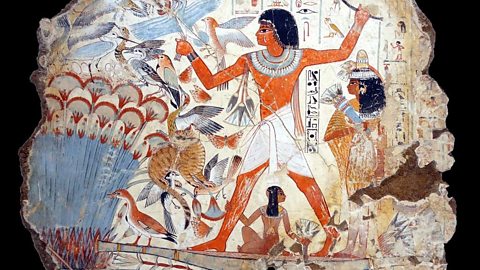
The Tomb of Nebamun, Egypt
Across the Mediterranean Sea from Italy, a remarkable group of frescoes can be found in the ancient Egyptian tomb of a man called Nebamun. Thanks to Egyptās arid climate, they have been well-preserved despite dating back to around 1350BC. Unlike traditional frescoes, these ones were painted onto dry white plaster, with palm branches used in place of brushes.
The frescoes appear to depict elements of daily life, with Nebamun shown hunting birds from a small boat among the reeds, together with his wife and daughter. This marsh location could be symbolic of rebirth in the afterlife. Also lurking by the reeds is an enterprising tabby cat, waiting to catch the startled birds. Other animals featured include Egyptian red geese, Plain Tiger butterflies and pied wagtails. The detailed texture of the animalsā feathers and fur is notable for how realistic it appears.
But who was Nebamun? Surprisingly, he wasnāt a pharaoh or some other high-ranking leader. He was in fact, a sort of ancient Egyptian civil servant, who worked as a grain counter at the temple of Amun. How he was able to afford or convince a painter of such skill to work on his own tomb is unknown.
The original site of the tomb is also unknown, as the grave robber who found and removed the frescoes in the early 1800s refused to share the precise location. We only know that it was in the ancient capital Thebes, now modern day Luxor, and that the frescoes would have been in the tombās upper chamber, viewable by grieving visitors looking to pay their respects, whilst his body was below.
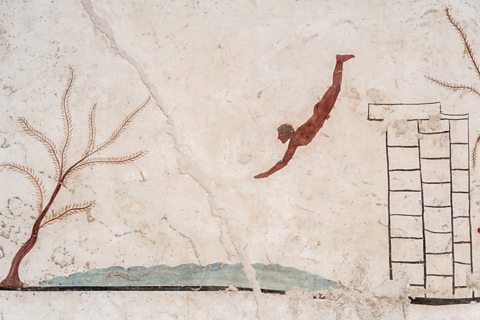
The Tomb of the Diver, Italy
Another tomb with unusual fresco decoration can be found in what was the ancient Greek city of Poseidonia (Paestum to the Romans), not far from the modern day Italian city of Salerno. Discovered in June 1968, the tomb contains five different frescoes, one on each limestone wall slab and one on the inside face of the ceiling slab. It is the latter, a painting of a young male diver, which is most famous.
Thought to date to roughly 500-470BC, these frescoes are the only Greek wall paintings from the period to survive in their complete forms.
The wall frescoes depict the goings-on of a symposium, a type of Greek social gathering where men would drink, dance, play music and discuss together. Various individuals can be seen lounging on coaches, either alone or two people, all wearing robes and laurel garlands. These sorts of scenes are quite common in ancient Greek art, but unusual in the context of a tomb.The image of the diver on the ceiling is particularly unusual as itās a rare subject matter in Greek art.
There are several different interpretations of what the diver might represent. One idea is that itās a metaphor for the moment between life and death, moving from this world to an afterlife. Of course, it may simply be a young man diving into some water.

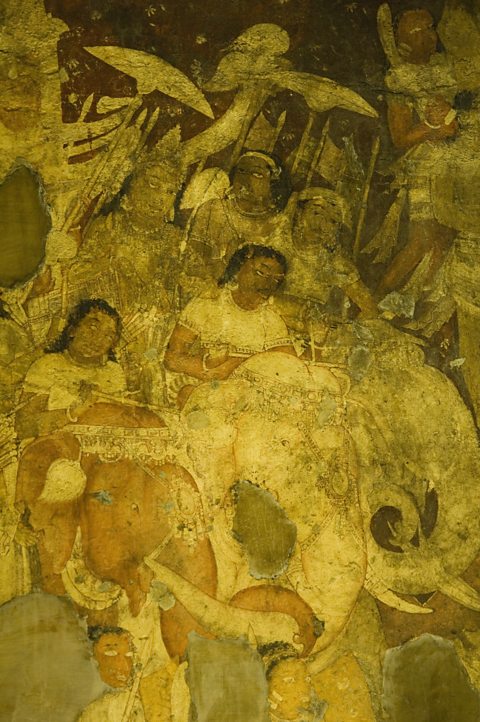
The Ajanta Caves, India
Not far from the city of Aurangabad in western India, there is a network of 30 caves cut into the side of a cliff, which once functioned as Buddhist monasteries and sanctuaries. Hidden inside them are numerous beautiful examples of Buddhist artwork in the fresco style, covering the walls, ceilings and pillars.
The frescoes of the Ajanta Caves can be neatly divided into two groups, based on when they were painted. The oldest of the frescoes date back to the first or second century BC, whilst the rest are from around the sixth century AD, during Indiaās Golden Age. It is thought that the older murals might be among the oldest Buddhist paintings in the world, but unfortunately, they are less well-preserved.
Numerous elements of Buddhist culture and stories of the lives of the Buddha (jatakas) are reflected in the murals, from meditating monks in orange robes to princes and princess, the bodhi tree to rival queens.
From analysing the colour pigments used in the later murals, experts have been able to work out that they were imported from regions such as Central Asia and the Iranian Plateau, indicating that the local society participated in trade. In addition, some of the murals contain figures wearing the clothing of other cultures. We also know who helped pay for the painting of some of the murals, because their names have been recorded in cave inscriptions.
Early attempts to preserve the murals caused further damage as the treatments used simply attracted further grime and oxidised to an unsightly reddish brown. However, in 1999 a painstaking process began to restore the paintings using the latest technology, which has proved more successful.
This article was published in May 2024

Five amazing sculptures from around the world
From the world's largest bird and equine sculptures to the face of Nelson Mandela, there's something to inspire everyone.

Can you guess the landmark from the aerial photo?
Take a look at these aerial photos and see if you can figure which famous landmarks they are, from right across the world.
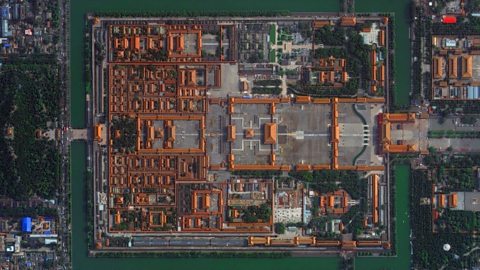
Looking for Atlantis? Five underwater cities from around the world
Dive below the surface and explore these incredible submerged communities.
